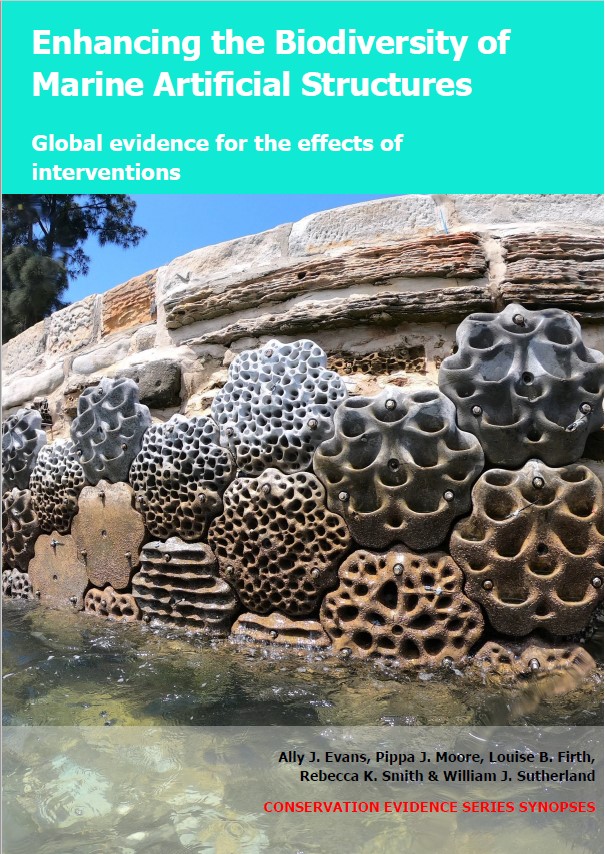Create small adjoining cavities or ‘swimthrough’ habitats (≤100 mm) on intertidal artificial structures
-
Overall effectiveness category Awaiting assessment
-
Number of studies: 2
View assessment score
Hide assessment score
How is the evidence assessed?
-
Effectiveness
not assessed -
Certainty
not assessed -
Harms
not assessed
Study locations
Supporting evidence from individual studies
A replicated study in 2011–2014 on 30 rock gabions on open coastline in the Irish Sea, UK and in the Eastern Scheldt estuary, Netherlands (Firth et al. 2014) found that gabions with small swimthrough habitats created amongst rocks of mixed sizes (small and large) supported similar macroalgae and invertebrate species richness and abundance to those amongst rocks of regular sizes (small or large), but that abundance was higher on gabions with regular small rocks than regular large ones. In the UK, after 12 months, 12 mobile and non-mobile invertebrate species were recorded in and on gabions with swimthroughs. Species richness and abundance was similar in and on gabions with swimthroughs amongst mixed-sized rocks (9 species/gabion, 252 individuals/gabion) and regularly-sized ones (8 species/gabion, 191–366 individuals/gabion). Abundance was higher in and on gabions with small regular rocks (366 individuals/gabion) than large regular ones (191/gabion). In the Netherlands, after 16 months, 14 macroalgae, mobile and non-mobile invertebrate species were recorded and overall species richness was similar on all gabion designs (data not reported). Small swimthrough habitats were created amongst rocks in gabion baskets (500 × 500 × 300 mm; 76 mm mesh size). Swimthroughs were either amongst rocks of mixed sizes (small: 60–100 mm and large: 180 mm), or amongst regularly-sized small or large rocks. Five of each design were placed at midshore on a boulder beach in the UK in April 2011 and at lower-midshore on a sandy beach in the Netherlands in September 2012. UK gabions were dismantled and invertebrates counted after 12 months. In the Netherlands, macroalgae and invertebrates on external horizontal gabion surfaces were counted after 16 months.
Study and other actions testedA replicated, controlled study (year not reported) in two intertidal boulder fields on open coastline in the Indian Ocean, South Africa (Liversage et al. 2017) found that small swimthrough habitats created under concrete blocks supported similar mobile invertebrate species richness, diversity and community composition to blocks without swimthroughs, but higher mobile invertebrate abundance. Swimthrough habitats supported similar mobile invertebrate species richness, diversity and community composition (data reported as statistical model results) but higher mobile invertebrate abundance (3 individuals/dm2) compared with blocks without swimthroughs (1/dm2). Small swimthrough habitats (length: 290 mm; width: 70 mm; height: 20 mm) were created on the undersides of concrete blocks (250 × 150 × 40 mm) using a mould. Twelve blocks with swimthroughs and 12 without were placed on the seabed in each of two natural boulder-fields (material, shore level and month/year not reported). Mobile invertebrates on the horizontal surface (roof) of swimthrough habitats and on the equivalent undersurface of blocks without swimthroughs were counted from photographs after seven weeks. Some blocks were missing and no longer provided habitat (numbers not reported).
Study and other actions tested
Where has this evidence come from?
List of journals searched by synopsis
All the journals searched for all synopses
This Action forms part of the Action Synopsis:
Biodiversity of Marine Artificial Structures
Biodiversity of Marine Artificial Structures - Published 2021
Enhancing biodiversity of marine artificial structures synopsis





)_2023.JPG)














